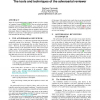26354 search results - page 128 / 5271 » How we refactor, and how we know it |
COMPLEXITY
2010
13 years 7 months ago
2010
Using Rule 126 elementary cellular automaton (ECA) we demonstrate that a chaotic discrete system -- when enriched with memory
HCI
2011
13 years 1 months ago
2011
Over the past 15 years, children have become more integrally involved in the design of their technology. In this paper, we present the idea that design partnering methods, specific...
JSYML
2010
13 years 8 months ago
2010
By taking a closer look at the construction of an Ackermann function we see that between any primitive recursive degree and its Ackermann modification there is a dense chain of p...
CHI
2009
ACM
14 years 11 months ago
2009
ACM
Communicating the subtleties of a craft technique, like putting a zipper into a garment or throwing a clay pot, can be challenging even when working side by side. Yet HowTo conten...
SIGMOD
2008
ACM
14 years 10 months ago
2008
ACM
There are several useful guides available for how to review a paper in Computer Science [10, 6, 12, 7, 2]. These are soberly presented, carefully reasoned and sensibly argued. As ...

